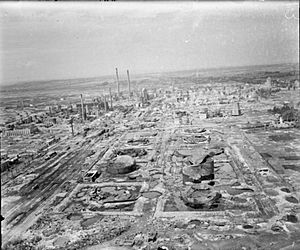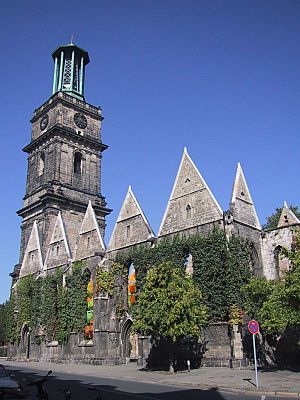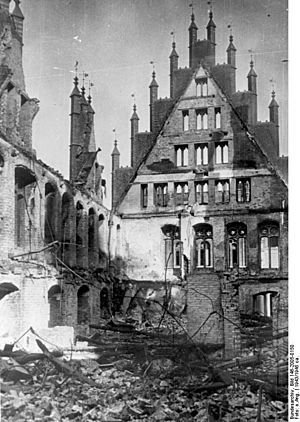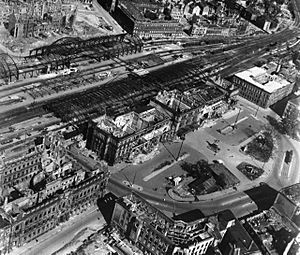Bombing of Hanover in World War II facts for kids
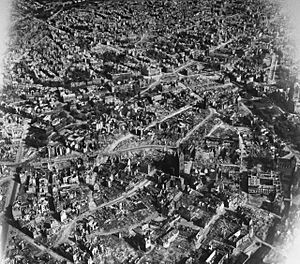
The bombings of Hanover were a series of air attacks on the German city of Hanover during World War II. These attacks were carried out by the Royal Air Force (RAF) and the United States Army Air Forces (USAAF). In total, there were eighty-eight air raids.
These bombings sadly killed 6,782 people, mostly civilians living in the city. About 1,000 aerial mines, 34,000 high explosive bombs, and 950,000 incendiary (fire-starting) bombs were dropped. The most damaging raid happened on the night of October 8, 1943. It was done by the RAF and killed 1,245 people. This was an example of "carpet bombing," where many bombs are dropped over a wide area, often targeting homes.
By the end of the war, 90% of Hanover's city centre was destroyed. More than half of all buildings (52%) were either badly damaged or completely ruined. A huge amount of rubble, about 7.5 million cubic meters, had to be cleared away. Out of nearly 150,000 homes in 1939, only about 5% were completely unharmed. Many important buildings, like the Aegidien Church and St. Nicholas' Chapel, were destroyed. They were later kept as memorials instead of being rebuilt.
Contents
Why Hanover Was Bombed
Before World War II, Hanover was a large city in Germany with about 471,000 people. During the war, many people left, and the population dropped to 217,000 by May 1945.
Hanover was very important for Germany's war efforts.
- Military Hub: It was a headquarters for a German army division and a military training area.
- Railway Junction: It had key railway lines that connected major routes across Germany. This made it important for moving troops and supplies.
- Industrial Centre: Hanover was one of the top industrial cities in Germany.
- Rubber Production: Three Continental AG factories made tires for military vehicles and aircraft, as well as other rubber parts.
- Vehicle and Weapon Production: Factories like Maschinenfabrik Niedersachsen Hannover and Hanomag produced guns and tracked vehicles.
- Battery Production: An AFA factory built batteries for submarines and torpedoes.
- Metal Production: A new factory, Vereinigten Leichtmetallwerke (VLW), built light metal parts.
- Fuel Refineries: Two large refineries, Deurag and Nerag, located just outside the city, produced aviation fuel and motor oils for the German air force (Luftwaffe). These refineries were often targeted by bombers.
Air Raids on Hanover
Hanover was a relatively easy target for British planes because it was not far from their bases in the United Kingdom. Also, nearby landmarks like the Steinhuder Meer lake helped pilots find their way. The large Maschsee lake in Hanover was partly covered with wooden boards and fake islands to make it harder to spot from the air. However, the clear patterns of the Great Garden in the Herrenhausen Gardens were still visible and used by RAF radar systems.
Early Raids (1939-1940)
The very first raid on Hanover was on September 4, 1939, the day after Britain declared war. It was just one British plane dropping leaflets, not bombs.
The first bombing raid happened on May 19, 1940, when the RAF attacked the Misburg refineries, killing nineteen people. On August 1, 1940, Hanover itself was bombed for the first time. Later that year, on September 30, six planes destroyed several buildings in the Wülfel and Linden areas.
1941 Attacks
On February 10, 1941, 220 British planes attacked the city, mainly hitting the eastern district and killing 101 people. More raids followed in April and June, targeting factories and refineries. Even though these attacks damaged the factories, they were often able to start production again.
The Big Raid of October 8, 1943
The night of October 8, 1943, saw one of the most devastating attacks. Over 500 RAF aircraft, including Lancasters and Halifaxes, attacked Hanover. The weather was clear, and the British "Pathfinder" planes accurately marked the city centre. This meant most bombs landed within the built-up areas. Many German night fighters tried to stop the attack, and 27 British planes were lost.
During this raid, the famous Ebstorf Map, the largest medieval map of the world, was sadly destroyed.
Later Raids
On March 28, 1945, the main railway station in Hanover was destroyed.


